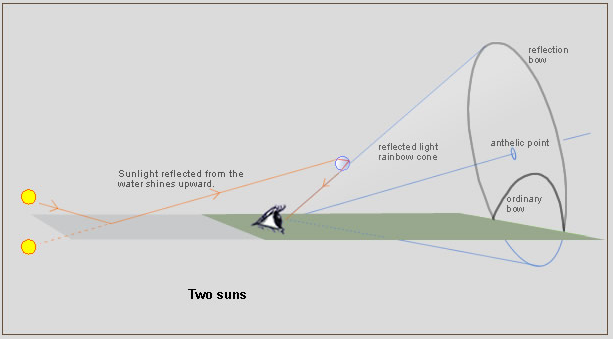Reflection rainbows formation
Reflection Rainbows Formation: A Phenomenon of Nature
Rainbows are one of nature's most captivating displays, but have you ever heard of reflection rainbows? While traditional rainbows are formed by the refraction and reflection of sunlight within raindrops, reflection rainbows are a unique optical phenomenon that occurs when sunlight is reflected off a smooth body of water, such as a lake or calm ocean surface. In this article, we will delve deeper into the formation of reflection rainbows and explore the fascinating science behind this captivating spectacle.
When sunlight strikes the surface of smooth water, it creates parallel shafts of light that are reflected upwards. To an observer standing nearby, this reflection appears as if a second sun is shining from below the horizon. The opposite point in the sky from the reflected sun is known as the anthelic point, which is located at the same distance above the horizon as the antisolar point is below it. It is at this anthelic point that the magic of reflection rainbows takes place.
Drops of rainwater on the surface of a cone-shaped region, with its axis pointing towards the anthelic point, play a crucial role in the formation of reflection rainbows. As sunlight enters these raindrops, it undergoes internal reflection and refraction before being reflected back towards the observer. This process causes the light to disperse into its constituent colors, creating a stunning array of hues similar to those seen in traditional rainbows.
Unlike traditional rainbows that arc across the sky, reflection rainbows form a circular shape around the anthelic point. However, it's important to note that the observer's position in relation to the water mirror plays a significant role in determining which parts of the reflection bow are visible. When the water mirror is behind the observer, they will be able to see the entire reflection bow. On the other hand, if the water mirror is in front of the observer, only the lower portions of the reflection bow will be visible.
The formation of reflection rainbows is not limited to large bodies of water. Even smaller bodies of water, such as puddles or dewdrops on grass, can create these mesmerizing optical phenomena. In fact, any smooth surface that reflects sunlight can potentially give rise to reflection rainbows, adding an element of surprise and wonder to our everyday surroundings.
It is worth noting that the phenomenon of reflection rainbows is not as well-known or commonly observed as traditional rainbows. This is largely due to the specific conditions required for their formation. The presence of smooth water surfaces and the precise alignment of the sun, observer, and anthelic point must all coincide to create the perfect conditions for reflection rainbows to manifest.
In conclusion, reflection rainbows are a remarkable natural phenomenon that occurs when sunlight is reflected off a smooth body of water, resulting in a circular bow of colors around the anthelic point. Although less common than traditional rainbows, the beauty and uniqueness of reflection rainbows make them a truly captivating sight. So, next time you find yourself near a calm lake or witness dewdrops glistening in the morning sun, keep an eye out for these elusive and enchanting optical wonders.

Reflection from smooth water sends parallel shafts of sunlight upwards. To falling raindrops this appears like a second sun shining upwards from below the horizon. The opposite point in the sky from the reflected sun is the anthelic point - the same distance above the horizon as the antisolar point is below it. Drops on the surface of a rainbow cone with an axis pointing to the anthelic point form a reflection rainbow.
The water mirror does not have to be behind the observer but when it is in front only the lower parts of the reflection bow will be seen.
Note: this article has been automatically converted from the old site and may not appear as intended. You can find the original article here.
Reference Atmospheric Optics
If you use any of the definitions, information, or data presented on Atmospheric Optics, please copy the link or reference below to properly credit us as the reference source. Thank you!
-
<a href="https://atoptics.co.uk/blog/reflection-rainbows-formation/">Reflection rainbows formation</a>
-
"Reflection rainbows formation". Atmospheric Optics. Accessed on December 22, 2024. https://atoptics.co.uk/blog/reflection-rainbows-formation/.
-
"Reflection rainbows formation". Atmospheric Optics, https://atoptics.co.uk/blog/reflection-rainbows-formation/. Accessed 22 December, 2024
-
Reflection rainbows formation. Atmospheric Optics. Retrieved from https://atoptics.co.uk/blog/reflection-rainbows-formation/.